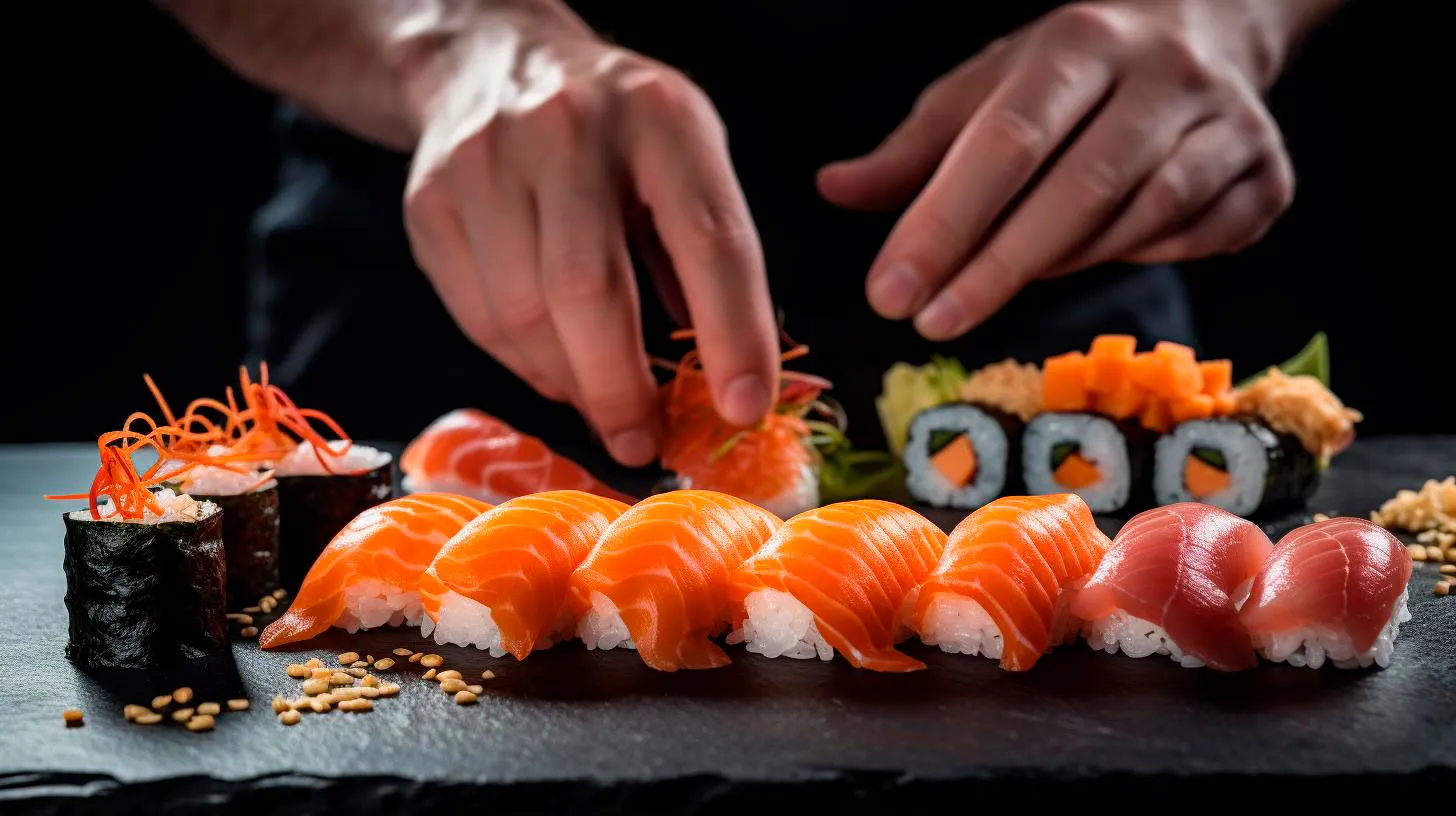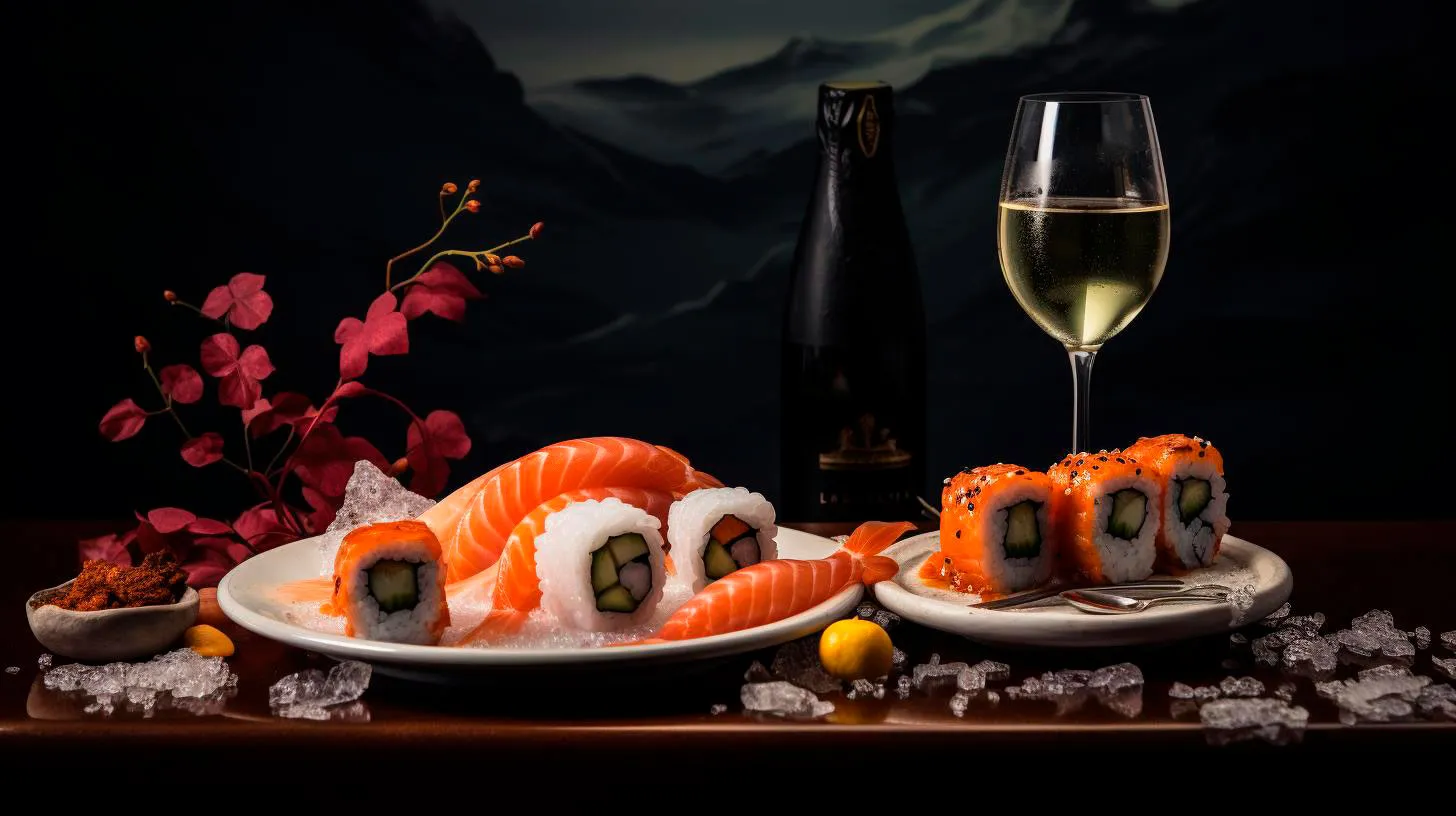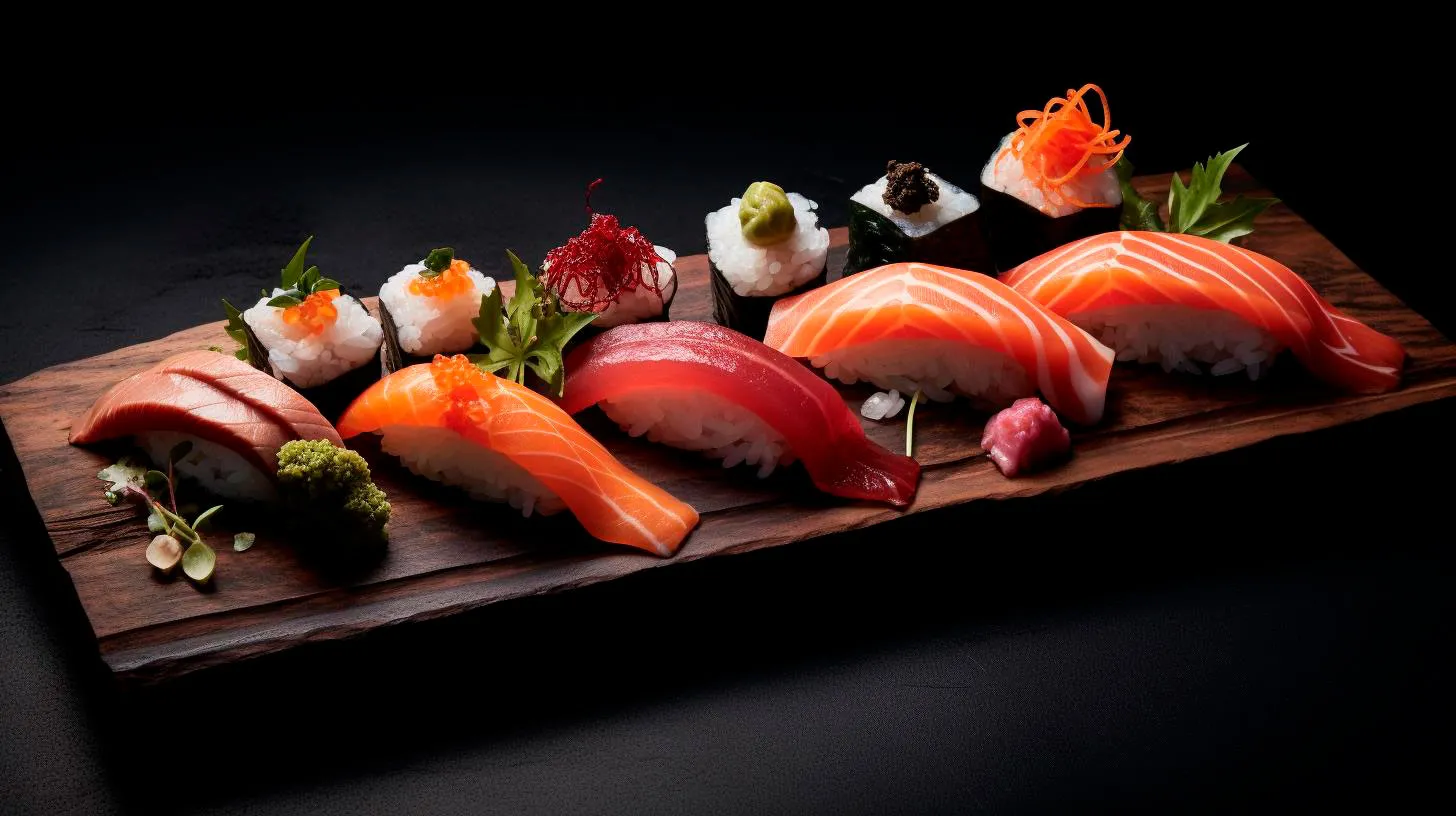Exploring Cultural Impact: Sushi’s Journey Across Borders
In this article, we will delve into sushi’s fascinating journey across borders, examining its cultural impact and the reasons behind its widespread popularity.
The Evolution of Sushi
Sushi’s roots can be traced back to ancient times when fish was preserved by fermenting it with rice. Over the years, this preservation method evolved, and the rice began to be consumed along with the fish. As rice cultivation spread across Japan, the technique of preparing sushi also developed, leading to the creation of different styles and variations of the dish.
During the 19th century, Japan experienced a period of cultural and economic transformation, known as the Meiji restoration. This era witnessed the modernization of the country and the opening up of its borders to foreign trade. Sushi, traditionally considered street food, gained recognition as an exquisite delicacy during this time, finding its way into higher-end restaurants.
Sushi Goes Global
Thanks to globalization and the increasing interconnectedness of our world, sushi ventured beyond Japan and began its journey across borders. Today, sushi is readily available in many countries, from high-end sushi bars in cosmopolitan cities to local supermarkets offering sushi rolls as a grab-and-go option.
The popularity of sushi can be attributed to several factors:
- Taste and Aesthetics: Sushi’s unique taste, with its combination of fresh fish, vinegary rice, and wasabi, has attracted a wide range of taste buds. Additionally, the visually appealing presentation of sushi, carefully crafted into bite-sized pieces, adds to the overall dining experience.
- Health Benefits: Sushi is often associated with a healthy lifestyle due to its emphasis on fresh ingredients, such as fish, vegetables, and seaweed. It is low in saturated fats and cholesterol, making it a popular choice for health-conscious individuals.
- Cultural Allure: Sushi represents Japanese culture and craftsmanship, and its consumption has become a cultural experience for many. From the elegance of traditional sushi preparation to the significance of sushi etiquette, people are drawn to the cultural allure surrounding this dish.
- Social Media Influence: The rise of social media platforms and food blogging has contributed to the popularity of sushi. Instagram-worthy sushi photos and videos have become viral content, further promoting its appeal and increasing its demand.
The Impact of Sushi
Sushi’s global popularity has had several significant impacts:
- The Promotion of Japanese Culture: Sushi has become a symbol of Japanese cuisine, leading to an increased interest in Japanese culture overall. This has resulted in a greater appreciation for other aspects of Japanese traditions, such as tea ceremonies, origami, and martial arts.
- Economic Growth: The global demand for sushi has created a thriving market, not only in Japan but also in many other countries. Sushi bars, restaurants, and even food delivery services have experienced tremendous growth, contributing to local economies and job creation.
- Cross-Cultural Integration: Sushi’s popularity has facilitated cross-cultural exchanges. The presence of sushi in various countries has allowed people to experience and appreciate different culinary traditions. This exchange of food and culture fosters understanding and acceptance among diverse communities.
Key Takeaways
Sushi’s journey across borders has been nothing short of remarkable. From its humble origins in Japan to becoming a global phenomenon, sushi has made a lasting impact on culinary traditions and cultural exchange. Here are some key takeaways:
- Sushi’s evolution showcases the adaptability and creativity of a traditional dish in changing times.
- Its popularity can be attributed to its taste, health benefits, cultural significance, and wide reach through social media.
- The impact of sushi extends beyond economic growth, fostering cross-cultural integration and promoting the appreciation of Japanese culture.
As sushi continues to evolve and adapt to new palates and culinary trends, its cultural impact will undoubtedly continue to spread. Whether enjoyed in a traditional manner or with modern twists, sushi exemplifies the power of food in bridging cultural gaps and bringing people together.
The Fusion of Tradition and Modernity: Admiring Japan’s Visual Artistic Legacy
In this blog article, we will explore Japan’s visual artistic legacy and how it continues to inspire and influence artistic expressions globally.
The Enduring Allure of Traditional Japanese Art
Traditional Japanese art forms, rooted in centuries of history and influenced by Buddhism and Shintoism, showcase the country’s distinct aesthetics and values. From ink paintings (sumi-e) and woodblock prints (ukiyo-e) to the delicate art of tea ceremony and flower arrangement (ikebana), each art form tells a unique story and exemplifies the meticulous craftsmanship of Japanese artists.
- Sumi-e: With a focus on simplicity, elegance, and minimalism, sumi-e paintings capture nature’s essence through black ink and brushstrokes. These Zen-inspired artworks often depict landscapes, flowers, and birds, evoking a sense of tranquility and serenity.
- Ukiyo-e: Developed during the Edo period (1603-1868), ukiyo-e prints played a significant role in shaping popular culture. These vividly colored woodblock prints depicted scenes of Kabuki actors, beautiful women, landscapes, and historical events, offering a glimpse into the lives of everyday people during that era.
- Ikebana: The art of flower arrangement, ikebana, emphasizes the harmony between nature and humanity. Through careful selection and placement of flowers, branches, and leaves, this ancient art form captures the ephemeral beauty and essence of life, providing a meditative and reflective experience.
Despite their historical significance, traditional Japanese art forms continue to inspire contemporary artists worldwide. The fusion of tradition and modernity is evident in the work of many Japanese artists who blend traditional techniques with contemporary themes and styles, creating a unique and innovative artistic expression.
The Rise of Manga and Anime
Manga and anime have gained immense popularity around the globe, becoming an integral part of Japan’s visual artistic legacy. These art forms, deeply rooted in traditional Japanese art, have captured the imagination of people of all ages and have become influential cultural exports.
- Manga: Originating from the 19th century with works like Hokusai’s “Hokusai Manga,” manga refers to Japanese comics that encompass various genres, from action and romance to fantasy and science fiction. Its distinctive visual style, characterized by large expressive eyes and dynamic facial expressions, brings stories and characters to life.
- Anime: Anime, the animated counterpart of manga, has evolved into a global phenomenon. Combining captivating storytelling, imaginative worlds, and unique aesthetics, anime has garnered a dedicated fan base worldwide. Successful anime franchises, such as Studio Ghibli’s works and “Dragon Ball,” have achieved international acclaim.
Contemporary manga and anime have revolutionized the visual arts scene, attracting audiences beyond Japan’s borders. Their accessibility, diverse storytelling, and visually stunning animation techniques have influenced animators, filmmakers, and artists worldwide, inspiring a new wave of creativity and artistry.
Key Takeaways: A Blend of Tradition and Modernity
Japan’s visual artistic legacy beautifully intertwines tradition and modernity, offering a wide range of art forms that captivate and inspire. Here are some key takeaways:
- Traditional art forms like sumi-e, ukiyo-e, and ikebana showcase Japan’s historical aesthetics and craftsmanship.
- The fusion of tradition and modernity is evident in many contemporary Japanese artworks.
- Manga and anime, deeply rooted in tradition, have become influential cultural exports, captivating audiences globally.
- The distinct visual styles and captivating storytelling techniques of manga and anime inspire artists and creators around the world.
Japan’s visual artistic legacy continues to shape and influence artistic expressions beyond its borders. Whether one admires the serenity of sumi-e, indulges in the vibrant world of ukiyo-e, embraces the grace of ikebana, or immerses oneself in the imaginative realm of manga and anime, Japan’s fusion of tradition and modernity offers an aesthetically rich and inspiring experience.
Unraveling the Intricate Threads of Symbolism in Japanese Visual Arts
The Art of Ikebana: Harmony and Balance
Ikebana, the traditional Japanese art of flower arrangement, goes far beyond simply placing flowers in a vase. It is a profound practice that combines aesthetics, philosophy, and spirituality. By carefully selecting and arranging flowers, leaves, and branches, ikebana artists aim to capture the essence of nature and represent the seasons.
Key Takeaways:
- Ikebana is not just arranging flowers but a profound art form.
- It focuses on capturing the essence of nature and representing the seasons.
- Harmony and balance are crucial elements of ikebana arrangements.
The Enigmatic World of Noh Theater
Noh, a classical Japanese musical drama, combines various art forms such as dance, music, poetry, and acting. Though seemingly simple in appearance, Noh performances are layered with symbolism and spirituality. The actors’ stylized movements and masks hold deep meaning, representing different characters, emotions, and levels of enlightenment.
Key Takeaways:
- Noh theater is a multi-dimensional art form combining dance, music, and poetry.
- Stylized movements and masks convey profound meaning.
- Symbolism and spirituality are integral parts of Noh performances.
The Intricacy of Ukiyo-e Prints
Ukiyo-e, the traditional Japanese woodblock printing technique, gained popularity during the Edo period. Through vibrant colors and intricate details, Ukiyo-e prints depict scenes from everyday life, legends, nature, and historical events. Behind their apparent simplicity, these prints often include hidden symbols and meanings, enabling viewers to explore different layers of interpretation.
Key Takeaways:
- Ukiyo-e prints showcase vibrant colors and intricate details.
- They represent various themes from everyday life to historical events.
- Hidden symbols add depth and allow for multiple interpretations.
The Zen Aesthetics of Rock Gardens
Rock gardens, known as karesansui, are an essential element of Japanese Zen temples. Combining carefully placed rocks, gravel, and moss, these minimalist gardens aim to create a tranquil and meditative environment. Each element in a rock garden has symbolic significance, reflecting nature’s beauty and imitating landscapes in a minimalistic and abstract way.
Key Takeaways:
- Rock gardens are found in Japanese Zen temples.
- They use minimalistic elements to create a serene and meditative atmosphere.
- Symbolism is crucial in reflecting nature and imitating landscapes.
The Mystique of Traditional Japanese Tattoos
Tattoos in Japan have a long history and were originally associated with criminals. However, the art of traditional Japanese tattoos, known as irezumi, has evolved into a respected and highly symbolic form of body art. Each motif and design used in irezumi carries specific meanings, often rooted in folklore, mythology, and nature.
Key Takeaways:
- Traditional Japanese tattoos are known as irezumi.
- They are highly symbolic and rooted in folklore and mythology.
- Each design and motif carries specific meanings.
In Conclusion
Japanese visual arts are a tapestry of symbolic threads, intricately woven to tell stories, convey emotions, and reflect the nation’s diverse culture. From ikebana to Noh theater, Ukiyo-e prints to rock gardens, and traditional tattoos, each art form serves as a lens to explore the complex layers of meaning deeply ingrained in Japanese art and society.
Whether you are an art enthusiast, seeking cultural enlightenment, or simply appreciating the aesthetic beauty, these art forms will undoubtedly leave you mesmerized and contemplative, with a newfound understanding of the profound symbolism entwined within Japan’s visual arts.
Sushi From Tradition to Innovation
In this blog article, we will explore the evolution of sushi, the technological advancements in the sushi industry, and the key takeaways from this fusion of tradition and innovation.
The Evolution of Sushi
Sushi originated in Southeast Asia as a method to preserve fish. It was introduced to Japan around the 8th century AD, and its transformation truly began. During the Edo period, in the 19th century, sushi became a common street food. However, it was not until the 20th century, with the invention of the refrigeration system, that sushi started to gain prominence. Refrigeration allowed sushi masters to maintain the freshness of fish, opening up new possibilities for experimentation.
In the early 20th century, the nigiri-zushi (hand-pressed sushi) technique was developed, revolutionizing the sushi experience. This style involves placing a slice of fresh fish over a small mound of vinegared rice. It quickly became the trademark sushi style, admired for its simplicity and elegance.
Technological Advancements in the Sushi Industry
The sushi industry has embraced technological advancements to enhance its production processes, increase efficiency, and ensure consistency in taste and presentation. Here are some noteworthy innovations:
1. Sushi Robots
- Sushi robots have transformed the way sushi is made in commercial quantities, allowing for faster production and standardization.
- These robots precisely measure rice and toppings, ensuring consistent sizes and weights for each sushi piece.
- They reduce the dependency on skilled chefs, enabling restaurants to cater to larger crowds while maintaining quality.
2. Conveyor Belt Systems
- Conveyor belt systems have revolutionized the sushi dining experience, allowing customers to choose from a wide variety of sushi passing by on a rotating belt.
- These systems increase convenience for both customers and chefs, reducing wait times and providing a visual treat.
- Restaurants can also track the popularity of different sushi plates, aiding in menu optimization.
3. Online Ordering and Delivery
- The rise of online platforms and delivery services has made sushi accessible to a larger audience.
- Customers can now conveniently order their favorite sushi from the comfort of their homes, making it a popular choice for takeout or delivery.
- Online platforms also allow for personalized customization and reviews, enhancing user experiences and building trust.
Key Takeaways from Tradition to Innovation
The fusion of tradition and innovation in the sushi industry has led to several key takeaways:
- Sushi has evolved from a preservation technique to an art form that delights the senses.
- Technological advancements have made sushi production faster, more consistent, and accessible to a larger audience.
- Sushi robots and conveyor belt systems have increased efficiency and convenience, benefiting both customers and chefs.
- Online ordering and delivery services have expanded the reach of sushi, making it a popular choice for meals at home.
As the sushi industry continues to evolve, it is important to remember and respect its rich cultural heritage. Tradition and innovation can coexist, breathing new life into this ancient culinary tradition. So, the next time you savor a piece of sushi, appreciate the journey it has taken from its humble beginnings to its modern-day innovation.



